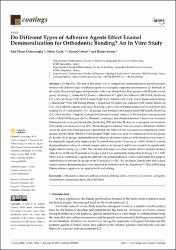| dc.description.abstract | (1) Objective: The aim of this study was to compare the demineralization around brackets bonded with different types of adhesive agents in a cariogenic suspension environment. (2) Methods: In the study, 60 extracted upper first premolar teeth were divided into three groups with 20 teeth in each group. In Group 1, Transbond XT Primer + Transbond XT Light Cure Adhesive (3M Unitek, Monrovia, CA, USA), in Group 2, GC Ortho Connect Light Cure Adhesive (GC Crop, Tokyo, Japan) and in Group 3, Transbond (TM) Plus Self Etching Primer + Transbond XT Light Cure Adhesive (3M Unitek, Monrovia, CA, USA) adhesive agents were used. In Group 1 and 2, buccal enamel surfaces were etched for 30 s, washed for 15 s and dried for 15 s. All groups were bonded with Gemini metal (3M Unitek, Monrovia, CA, USA) brackets. Gingival, occlusal and proximal enamel surfaces of the brackets were measured with a DIAGNOdent pen (KaVo, Biberach, Germany), and demineralization values were recorded. Measurements were performed after bracketing (T0) and after 28 days in a cariogenic environment (T1), which was renewed every 48 h. The Kolmogorov-Smirnov test was used to determine whether or not the data were homogeneously distributed, the Wilcoxon test was used for comparisons within groups, and the Mann-Whitney U and Kruskal-Wallis tests were used for comparisons between groups. (3) Results: In all groups, demineralization values on all enamel surfaces of the brackets were found to be statistically significantly higher in the T1 period than in the T0 period (p < 0.05). In the T1 period, demineralization values of occlusal enamel surfaces in Groups 1 and 2 were found to be significantly higher than in Group 3 (p < 0.05). The amount of increase in occlusal enamel surface demineralization value between T0 and T1 periods in Groups 1 and 2 was significantly higher than in Group 3 (p < 0.05). There was no statistically significant difference in demineralization values of proximal and gingival enamel surfaces between the groups in the T1 period (p > 0.05). (4) Conclusion: Significantly less occlusal enamel surface demineralization was observed in teeth in which the Transbond (TM) Plus Self Etching Primer adhesive agent was not applied with acid etching. | en_US |



















